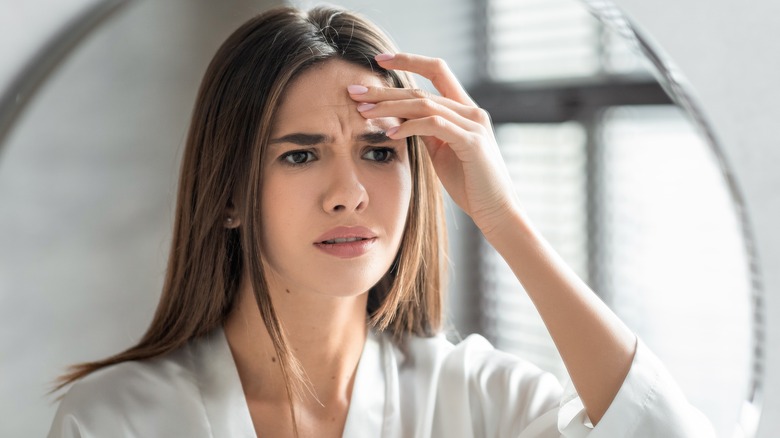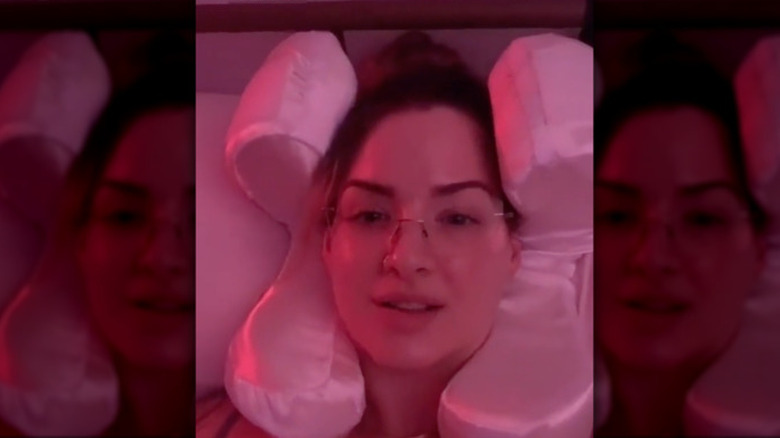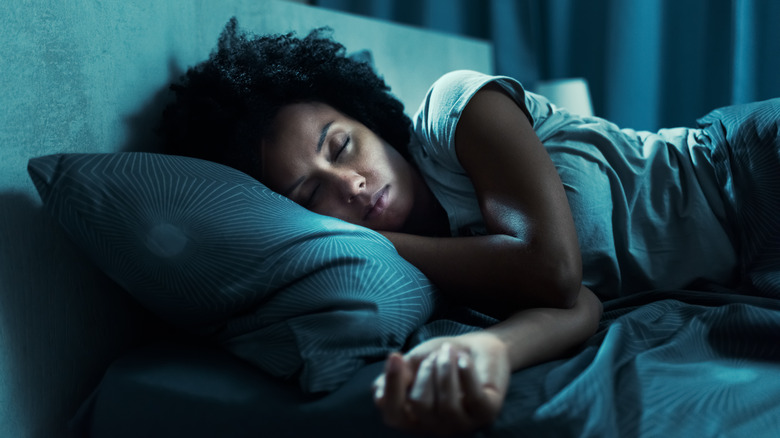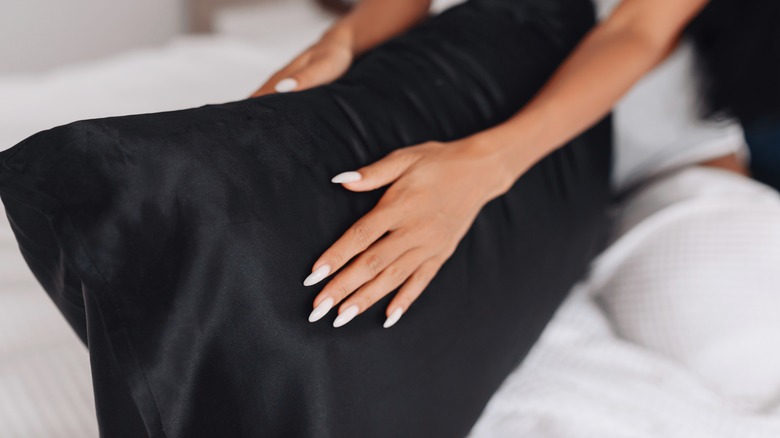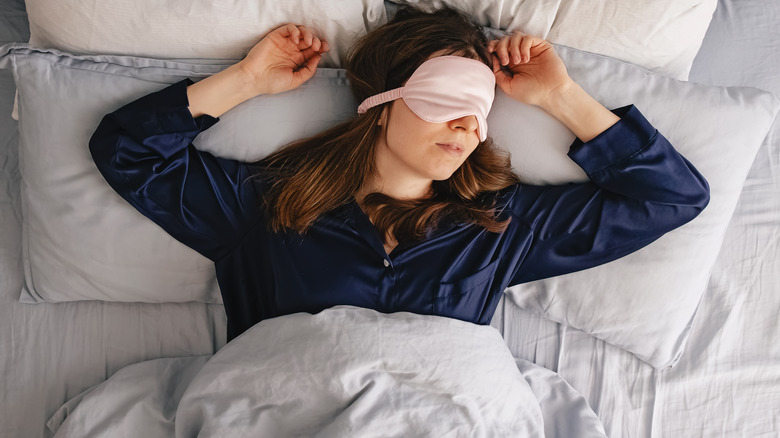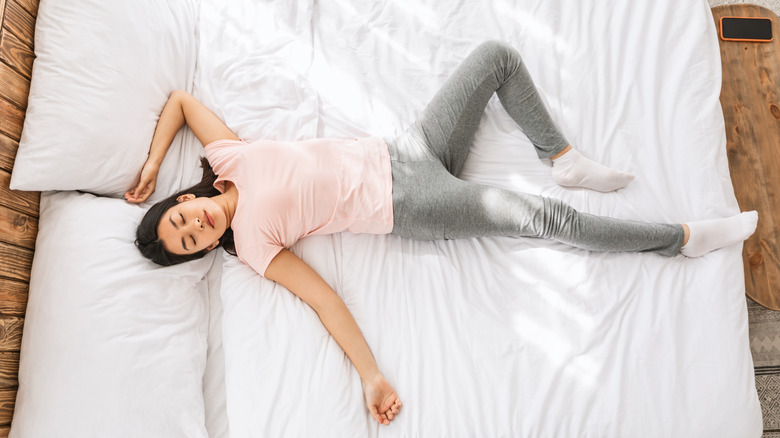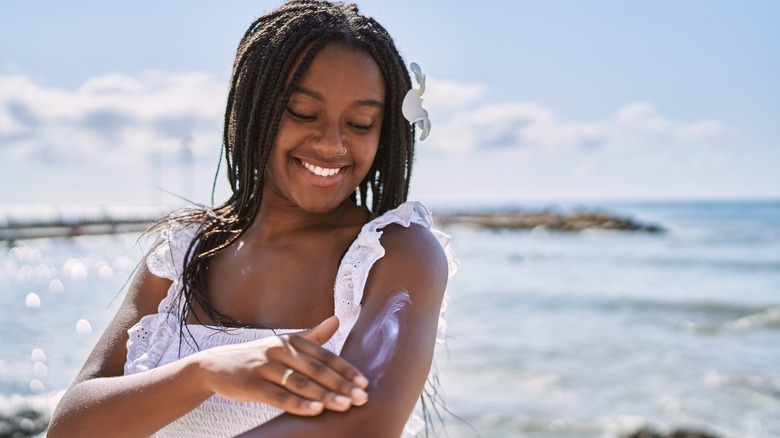Is TikTok's 'Anti-Aging' Pillow Trend Worth The Hype?
Whether you're a frequent TikTok user or you don't bother to keep up with what's going viral, it's hard to avoid some of the trends that go mainstream. As of late, #antiagingpillow has become a popular hashtag as TikTok creators continue to seek the Fountain of Youth — but what is this pillow, and does it help combat signs of aging?
As board-certified dermatologist, Dr. Lian Mack told Shape, anti-aging pillows (as they're being deemed on social media) come in various shapes and sizes but are often drastically different than a standard pillow. When you use one to sleep, the goal is to minimize how much contact your face has with the pillow. Many anti-aging crusaders believe that the everyday pillow can contribute to the development of wrinkles over time. "The creation of these pillows is centered on the idea that wrinkles of the face are caused not only by muscle contraction but also by the distortion of facial structures from pillow contact at night," Dr. Mack explained to the publication.
As it turns out, using a type of pillow that avoids putting pressure on your face — just like the anti-aging ones being touted on TikTok — can help slow the development of wrinkles. Combined with other preventative anti-aging measures, such as using sunscreen and sleeping on your back, you can gain a leg up on Father Time.
Do every day pillows create signs of aging?
One reason people are flocking to products like anti-aging pillows is because of the notion that lying on our pillows is quite literally creating wrinkles. When the fabric becomes contorted and presses up against our faces, many people believe we're speeding up the development of fine lines — but is this actually true?
"If you consistently sleep on the side of your face, you may see lines develop from the pressure," Dr. Devika Icecreamwala, a board-certified dermatologist, told Glamour. Other experts echo this sentiment, noting that sleeping on your side or stomach, in particular, might result in those unwanted signs of aging. Many of the anti-aging pillows seen on social media platforms, like TikTok, come in non-traditional shapes for this very reason — to promote sleeping on your back, where there's less chance of your face being pressed against any fabric. In that respect, it would seem that these trendy pillows do exactly what they promise.
However, there's even more science that backs up the claims being made by TikTok creators touting anti-aging pillows. If you're a side sleeper, you may want to consider what that applied pressure does to your face while you're dreaming. As it turns out, it might sound like a nightmare if you have a vested interest in reducing signs of aging.
The science of how wrinkles form while we sleep
If you think you might unintentionally counter your efforts to maintain youthful-looking skin while you sleep, you may want to rethink your preferred sleeping position. As previously noted, added pressure to your face during the night can contribute to the visibility of fine lines — but there is actual science behind why this occurs. "When you sleep on your face at night, you're compressing the lymphatics (lymph nodes), which means you get more swollen," oculoplastic surgeon Dr. Kami Parsa told Shape. "Initially, these lines are temporary, but as [you] get older, [your] face can't bounce back as easily. Therefore, one way to prevent these lines is to avoid sleeping on your face, hence the use of anti-aging pillows."
Whether you're a stomach sleeper or prefer to fall into a slumber on your side, all that pressure on your body can work against your efforts to prevent fine lines. "[Anti-aging pillow benefits include] decreased sleep wrinkles and creases, decreased face puffiness, as well as helping with acne by reducing the tugging of the skin by the fabric, which may further inflame breakouts," board-certified dermatologist Dr. Lian Mack told Shape. As it turns out, investing in one of these trendy pillows might not be the worst idea if wrinkles are a primary concern for you. Now, you'll just need to narrow down your options!
A beneficial alternative to the anti-aging pillow
The unusual shapes of the trendy anti-aging pillows seen on TikTok can sometimes be just as uncomfortable as they look. However, Shape notes that these pillows tend to be relatively safe for most adults because they are often designed to be used while positioned on your back. If you have any concerns once you begin using one, don't hesitate to bring them up to your doctor.
After trying out an anti-aging pillow and adjusting your sleeping habits, you might find that the product just isn't for you. That being said, this doesn't mean you have no other options if you still want to minimize the impact of your traditional pillow. Silk pillowcases have been trendy for quite some time, and for a good reason — these pillowcases can resolve many hair and skin issues. "We get 'crush wrinkles' from sleeping on our side/face, so we may get less of those when sleeping on silk," dermatologist Dr. Neal Schultz explained to Good Housekeeping. The smoothness of silk ultimately reduces how much our pillowcase "tugs" at our skin during the night.
This lack of friction can be beneficial for your hair, too. The texture of a silk pillowcase not only reduces tangling but also limits frizz that develops from friction. Compared to cotton, which is more porous, silk is less likely to absorb moisture as well. This can benefit both your hair and skin, especially during the winter.
Can an eye mask make all the difference?
You may already know people who can't fathom going to bed without an eye mask. However, one underlying benefit of wearing one of these masks is preventing fine lines and wrinkles. "Nighttime masks do a good job of keeping skin in place while you sleep, so even if there is a lot of pressure, the skin does not fold on itself," board-certified dermatologist Dr. Rachel Nazarian explained to Byrdie.
MedicalNewsToday notes that limited research has been done on the skin benefits of wearing an eye mask (most studies have focused on the sleep advantages). However, this doesn't mean you can't try it, as the risk is minimal. Keeping your skin in mind, make sure you choose an eye mask made of a breathable fabric. Ideally, the mask should also be washable — the buildup of oil and other products from your face can lead to breakouts. Don't forget to follow the instructions if you choose a heating or cooling eye mask as well. Applying one of these masks directly onto your skin can result in a burn or frostbite.
If you want to take advantage of the sleep benefits of wearing an eye mask, choose one dark enough to shade your eyes from light — doing so can prevent sleep interruptions.
How to retrain your body to change your sleeping position
Even if you invest in a silk pillowcase, you may still be fearful of how your sleeping habits could impact the development of wrinkles. If you want to make additional changes to combat signs of aging, you can consider altering your sleeping position altogether. As Healthline explains, it's possible to train yourself to sleep on your back, which can alleviate pressure on your face.
One way to get used to this position is to simply grab a spare towel. Roll it up tightly, and use hair ties or rubber bands to keep it in its formed shape. As you lay down on your back in bed, place the towel underneath your neck for support. Not only will you "re-train" yourself to adjust to this position, but you'll also provide yourself with neck support, which can prevent pain in this area when you wake up.
Another way to train yourself to sleep on your back is to place a pillow underneath your knees or lower back, according to Health. You can also put pillows on both sides of your body near your midsection — this can discourage rolling over onto your side in your sleep. If all else fails, there are contoured pillows on the market that are specifically made to make it more comfortable to sleep on your back. This position can help you prevent back pain by aligning your spine.
Other ways to prevent signs of aging
The battle against signs of aging does not get easier with time. However, there are preventative measures that you can take to give yourself peace of mind, and they go beyond investing in a pillow seen on TikTok. As the American Academy of Dermatology Association explains, perhaps the most effective way to prevent premature signs of aging on your skin is to shield it from the sun. Even if you're not at the beach, wearing broad-spectrum sunscreen (SPF 30 or higher) can protect you from the sun's harmful, damaging ultraviolet rays. Additionally, it can reduce your odds of developing skin cancer.
Changing some of your daily habits can also help you fight off wrinkles and fine lines. This means not smoking, limiting alcohol consumption, and eating a well-balanced diet. Finally, don't underestimate the impact of how you treat your skin. This may mean gently cleansing your skin rather than scrubbing it and causing irritation, but it might also mean understanding the ingredients in your skincare products. Healthline notes that some ingredients, like polyethylene glycols (PEGs), can irritate the skin. Others, like phthalates, have been thought to impact hormones and increase cancer risk. Talk to your doctor or a dermatologist if you're interested in learning how to address signs of aging safely.
